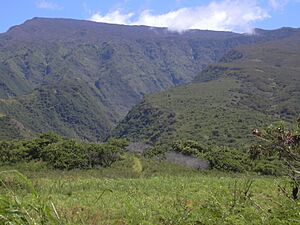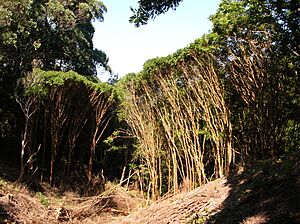Cattley guava facts for kids
Quick facts for kids Cattley guava |
|
|---|---|
 |
|
| Red Cattley guava fruit | |
| Scientific classification | |
| Genus: |
Psidium
|
| Species: |
cattleyanum
|
The Cattley guava, also known as strawberry guava or cherry guava, is a small tree. Its scientific name is Psidium cattleyanum. It belongs to the Myrtaceae family, which includes plants like myrtle. This tree was named after an English plant expert, William Cattley. The name Psidium comes from a Latin word meaning "armlet."
There are two main types of Cattley guava:
- The red-fruited type, P. cattleyanum var. cattleyanum, is often called purple guava, red Cattley guava, or red strawberry guava.
- The yellow-fruited type, P. cattleyanum var. littorale, is known as yellow Cattley guava, lemon guava, or waiawī in Hawaii.
Even though people use P. cattleyanum for some things, it is known as the most harmful invasive plant in Hawaii.
Contents
What is Cattley Guava Like?
Psidium cattleyanum is a small tree with many branches. It usually grows to be about 2 to 4 meters tall, but can reach up to 13 meters. Its bark is smooth and can be grey or reddish-brown. The leaves are oval-shaped and grow up to 4.5 cm long.
Fruit and Flowers
This tree starts to grow fruit when it is about 3 to 6 years old. The fruit has thin skin and can be yellow, dark red, or purple. It is oval and grows to about 4 cm long. The flowers grow either alone or in groups of three. Each flower has five petals.
How it Spreads
P. cattleyanum spreads in two ways: by making seeds and by growing new plants from its roots (cloning). Plants grown from roots often have bigger leaves. This tree is originally from Brazil. But now, you can find it in many tropical places around the world. It was brought to Hawaii as early as 1825 for its fruit. However, it never became a big commercial crop there. Now, it is very common in tropical rainforests. This is mostly because its seeds are spread by accident.
Uses of Cattley Guava
Cattley guava has some uses, especially in Hawaii. Its fruits are edible. People also make beads by tying the fruits together. However, you usually can't buy products made from P. cattleyanum in stores. This is because there isn't a big market for them. Also, fruit flies often damage the fruits soon after they are picked, making them hard to sell.
The seeds of the fruit are quite healthy. They have things that help fight damage in your body (antioxidants). They also help reduce swelling (anti-inflammatory) and fight germs (antimicrobial). Plus, they have a lot of Vitamin C.
Where Cattley Guava Lives
P. cattleyanum mostly grows in wet tropical rainforests. It prefers places that are up to 1300 meters high, but it is most common below 800 meters. Its natural home is in the Amazonian Basin in Brazil. But it has now spread to many other tropical areas that have similar weather.
Why it's Invasive
In its native home, P. cattleyanum does not take over other plants. But in other places, it becomes an invasive species. This is because it can grow well in many different environments. You can find P. cattleyanum in both untouched forests and disturbed areas like roadsides.
One reason it spreads so much is that it has a lot of genetic variety. Different types of the plant, like those with different fruit colors, grow at different heights. Also, P. cattleyanum can grow well in shady places. It can also handle soils that are not too acidic. If its branches bend or break, it can grow new strong shoots quickly.
Role of Feral Pigs
P. cattleyanum is often found near feral pigs. These two species are linked because feral pigs help spread the guava. The pigs dig in the soil, which makes it easier for guava seeds to grow. Also, pigs eat the fruits. The seeds then pass through the pigs' bodies and are spread in their waste.
Some early studies suggest that P. cattleyanum might be allelopathic. This means its roots might release chemicals that stop other plants from growing nearby.
Cattley Guava as an Invasive Species
Cattley guava is native to Brazil, where it is called araçá. It is closely related to the common guava (P. guajava). Like the common guava, it is a very widespread and harmful invasive species. You can find it in tropical areas across the Indian and Pacific Oceans. It also grows in humid subtropical forests, like in the Azores, though it is less invasive there.
Problems it Causes
This tree often forms thick, dense patches. These patches stop native plants from growing. It is also very hard to get rid of once it takes over an area. Cattley guava also provides a home for fruit flies. These flies can cause a lot of damage to farm crops.
The plant spreads quickly because its seeds fall to the ground. Birds and feral pigs also eat the fruits and spread the seeds. New plants can also grow from its roots.
Sometimes, P. cattleyanum is wrongly called Chinese guava. It was brought to many places where it is now invasive because people wanted to grow its edible fruit.
Where it's Invasive
Cattley guava has become wild in coastal areas of Queensland and northern New South Wales in Australia. It is also found on Lord Howe Island, Norfolk Island, and Christmas Island. The yellow-fruited type produces even more fruit than the red type and usually has larger fruits.
P. cattleyanum grows well even in untouched areas. This makes it harder to restore sensitive natural habitats. It is also very common in damaged areas. This makes management difficult because its seeds can easily spread from these less sensitive places to more fragile ones.
Cattley guava causes harm by creating dense thickets. These thickets block sunlight, which stops other plant species from growing. It can grow well in many different habitats and conditions. This threatens native plants in many different types of environments. Also, its possible allelopathic qualities might make it even harder for other plants to live near it.
Guava is also one of the most invasive species on Réunion island. There, it is a big threat to the native forests.
How to Control Cattley Guava
People use many different ways to try and control P. cattleyanum. This is because it is found everywhere and spreads in many ways. Even though it is a big threat to many tropical places, some studies show that small groups of the plant can be completely removed. This can happen after three to four years of careful work. This work includes cutting down mature trees and using chemicals on the stumps. However, people need to keep managing the area for a long time after the main removal.
This control method is called "special ecological areas." It is one of the best ways to control plant species over time. It focuses on removing wood, burning, and other control efforts in specific areas.
Controlling Spreaders
Feral pigs and non-native birds help spread P. cattleyanum seeds. So, some control efforts try to remove or control these invasive animals. But these efforts are often not successful. This is because the guava does not completely depend on these animals to spread. Its seeds can grow in many different conditions.
Using Insects for Control
Another way to manage the plant is to bring in insects that harm the invasive plants. This is called biological control. Certain insects can damage P. cattleyanum in ways that stop the tree from making fruit or even kill it. Most of the insects suggested for this cause galls (unusual growths) on the buds or leaves. This stops the fruit from growing or prevents the plant from making food through photosynthesis. For example, an insect called Diasineura gigantea caused bud galls that stopped new shoots from growing.
The Brazilian Scale is another insect that could be used for biological control. It is being considered in Florida and Hawaii. However, some insects cannot be used because they might attack other plants too. For example, a type of sawfly (Haplostegus epimelas) attacked guava plants grown for sale, not just the invasive P. cattleyanum.
Uses of Cattley Guava
You can eat the whole Cattley guava fruit. Both its thin skin and juicy inside are soft and tasty. People also use it to make jam. Sometimes, the skin is removed to make the flavor sweeter. The seeds are small and white.
You can also brew the leaves to make tea. The wood of the tree is hard, strong, and lasts a long time. It is used for things like turning wood on a lathe, making tool handles, and for charcoal and firewood. In Brazil, this plant is very important for planting in mixed forests to help restore and protect areas.
Gallery
-
Illustration by John Lindley
See also
 In Spanish: Guayabo peruano para niños
In Spanish: Guayabo peruano para niños








